
A nonprofit group of sustainable building advocates in Canada has proposed a new metric for measuring the amount of greenhouse gas emissions that can be attributed to the building industry, arguing that accounting for energy efficiency alone isn’t enough.
Builders for Climate Action, an offshoot of the Endeavour Centre building school in Ontario, has previously published work underlining the importance of measuring embodied carbon in building products such as insulation and siding. Choosing building materials with low levels of embodied carbon (which it now calls Material Carbon Emissions, or MCE) can have a more profound impact on climate change than focusing solely on energy efficiency, or what it calls Operational Carbon Emissions, or OCE, the group says.
The new report (EnerCan) notes that Canada is committed to reducing greenhouse gas emissions by 40% to 45% below 2005 levels in less than a decade, with full carbon neutrality by midcentury. But concentrating only on energy efficiency—greenhouse gas emissions from heating and cooling buildings—won’t be enough. The reason is that current standards ignore the significant impact of carbon produced by manufacturing building products in the first place, and does not take into account greenhouse gas emissions from power plants.
“The current regulatory framework addresses only energy efficiency and ignores MCE and fuel source emissions,” the study says. “Canada will not be able to assist the home building sector to truly achieve net-zero carbon while energy efficiency remains the only metric.”
With that in mind, the group is proposing a new metric called Carbon Use Intensity that would combine the impact of operational carbon, embodied carbon, and the carbon intensity of the local electric grid. Without this broader approach, its new report says, Canada’s progress toward carbon neutrality will stall.
Study looks at three housing types
Researchers looked at the impact of embodied and operational carbon in three typical house types in five Canadian cities (a bungalow, a two-story house, and a row-house end unit). They studied all-electric homes in the top three levels of Canada’s five-tiered National Building Code.
Depending on the amount of embodied carbon in the building materials that were used in the modeling, total carbon ranged from a high of 758 kilograms per square meter to a low of -84 kg C02/m2 (carbon storage instead of carbon emissions). Emissions could be reduced without changing the design or performance of the house, and lower carbon materials didn’t necessarily cost any more than those with high carbon content. Insulation, exterior cladding, and concrete had the highest impact on results.
Levels of operational carbon depend on the carbon intensity of the local source of electricity, and that varied by city. Vancouver, Toronto, and Quebec all have relatively low-carbon grids, for example, while Halifax and Prince Albert do not.
Ironically, the research found that houses built to more stringent energy standards may have higher levels of material carbon emissions, mainly because they typically have more insulation in them. Thicker layers of insulation with lots of carbon—closed-cell polyurethane foam, for instance—means a lot more overall carbon in the building.
Emissions could increase by 93 kg C02/m2 as energy efficiency increased, the study says, when materials with high levels of carbon are used. That, the authors say, “presents a cautionary warning that the pursuit of energy efficiency without consideration of material emissions can cause dramatic increases in overall emissions.”
In short, in the higher tiers of the National Building Code at least, material carbon emissions are more important than operating carbon.
What about costs?
The two materials with the highest carbon impact are insulation and exterior cladding, the report says, but there’s “no direct correlation” between embodied carbon in these materials and how much they cost.
“In some cases, the material with the best MCE had low costs while the material with the worst MCE had the highest costs,” researchers said. “Sometimes the inverse was true.”
In the case of wall-cavity insulation, straw bales had the highest potential for carbon storage and the lowest cost (-128 kg carbon and $49.11 respectively for a given area of R-10 insulation). Other low-carbon options include hempcrete, wood-fiber batts, cellulose batts, and dense-pack cellulose. However, hempcrete and wood-fiber batts also were considerably more expensive than other options. Likewise, imported wood-fiber board insulation had the lowest embodied carbon in its class, but also cost nearly four times as much as EPS foam with graphite.
Closed-cell spray polyurethane foam was cheap ($10.66) from a materials-only perspective but also had the highest amount of embodied carbon (232 kg), according to the report. When factoring in installation, spray polyurethane foam is one of the most expensive insulation options.
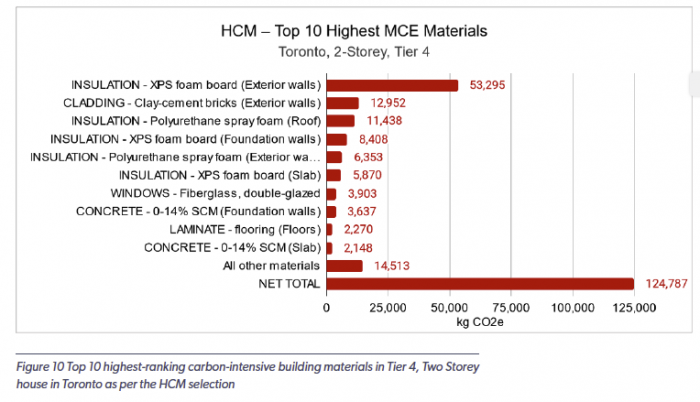
For cladding, unfinished spruce-pine-fir had very low levels of embodied carbon but was substantially more expensive than stucco and steel panels. Brick, on the other hand, was carbon heavy and also the most expensive cladding that researchers studied.
“This study points out the significant emissions impacts of MCE, but it also points to a solution by demonstrating the feasibility of creating new homes with a net-zero MCE impact,” the report says. The best available materials are widely available and fully code compliant, with the average material carbon emissions in houses that used them carbon negative.
The report continued, “These are very encouraging results. It is rare to find a viable pathway to reduce a major greenhouse gas source to zero using existing materials, designs and code scenarios. However, these results clearly show that it is possible to build new homes that are code-compliant, energy-efficient, and built using widely available products, while also having net-zero material carbon emissions.”
Making a case for Carbon Use Intensity
While the National Building Code has established ways of reducing energy consumption in buildings by improving mechanical systems and building enclosures, the report says, fuel-source emissions and material carbon emissions need more attention. That’s where Carbon Use Intensity comes in.
“The key recommendation from this study is to consider adopting a unified metric for measuring and regulating emissions in the home-building sector that combines all three emissions factors into a single metric: Carbon Use Intensity (CUI),” the authors said. “The current regulatory framework addresses only energy efficiency and ignores MCE and fuel source emissions.”
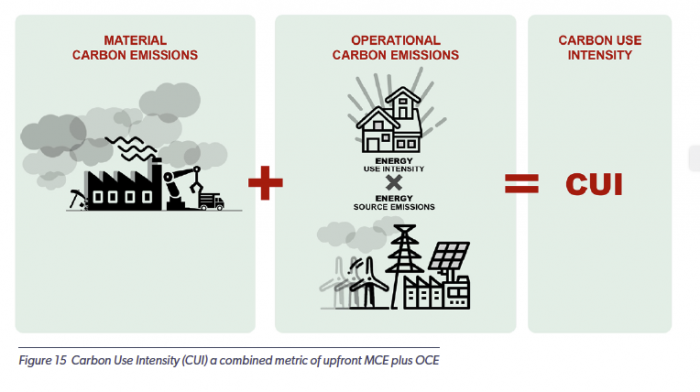
Adopting this accounting method would allow more accurate measurements of greenhouse gas emissions from buildings and would allow “regionally appropriate ways” to reach carbon targets. Where clean electricity is available, for example, the focus for improving CUI would focus on material carbon emissions. In areas where electricity comes with a higher carbon price tag, CUI reductions could be made by working to lower both material and operational carbon.
“Anywhere in the country, designers and builders could respond to any national, provincial, or regional CUI regulations while pursuing a CUI strategy that meets the needs of their clients and the climate with as much flexibility as possible,” the authors said.
Looking ahead to code adoption
In Canada, the National Building Code is updated every five years, said Chris Magwood, director of programs, research, and policy at the Endeavour Centre, and the lead author of the report. Some provinces use the National Building Code and others roll it into provincial codes, he said. British Columbia is the first province to move toward the new five-step code, with some provincial cities already mandating Step 3 while offering incentives for the use of Steps 4 and 5. By 2030, the entire country is due to be on Step 5, Magwood said.
“This report was commissioned by Natural Resources Canada, and they oversee energy efficiency programs in Canada,” Magwood said in an email. “They are interested in CUI, and I think they are testing the waters with this report.”
He continued: “There is a strong interest at NRCan in bringing this forward into programs. The federal government’s new climate mandate puts a lot of pressure on all departments to get the country to its 2040 commitments. But I have no idea how all of that works or where it might go!”
Asked what kind of reception the recommendation has gotten from the residential building industry, Magwood said that he has been asked by the Canadian Homebuilders Association to present the findings of the report this fall.
“From the developer/builder community, it appears much easier to make a bigger climate impact with affordable material swaps than with ever decreasing returns on expensive efficiency measures, ” he said, “especially in provinces with cleanish electrical grids.”
Contacted by email, the National Association of Homebuilders, a trade group representing U.S. residential builders, said it has taken no position on embodied carbon and couldn’t comment on the proposal.
What about the major code-writing organization in the U.S., the International Code Council (ICC)? Its International Residential Code (IRC) and International Energy Conservation Code (IECC), which are updated on a three-year cycle, are the basis for most state codes in the country.
Ryan Colker, vice president of innovation at the ICC, said the organization recognizes the need to address greenhouse gas emissions associated with both operational energy use and embodied carbon. But Colker did not indicate that the ICC is weighing anything like the Canadian proposal.
“While the challenge is relatively simple,” he said in an email, “the solution is complex. After all, buildings and the materials used to construct them must often meet multiple performance goals including durability, fire safety, structural integrity, and sustainability. Designers, owners, and building regulators need the tools to effectively weigh these performance requirements and the characteristics of different material choices to determine the optimum solution.”
He continued: “For example, if a specific material has low embodied carbon but is not particularly durable, it may need to be replaced more frequently than another material that may have a higher level of embodied carbon. Consistent approaches to measuring both embodied carbon and other important attributes across materials, and then the building as a whole, is required to make informed decisions.”
Colker said the ICC would “continue to explore this area.” He also pointed to gains in reducing operational energy use prompted by progressively tougher codes—a 40% improvement in energy efficiency in the IECC since 2006.
Scott Gibson is a contributing writer at Green Building Advisor and Fine Homebuilding magazine.
Weekly Newsletter
Get building science and energy efficiency advice, plus special offers, in your inbox.





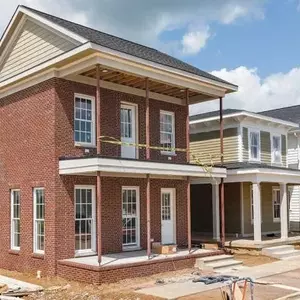
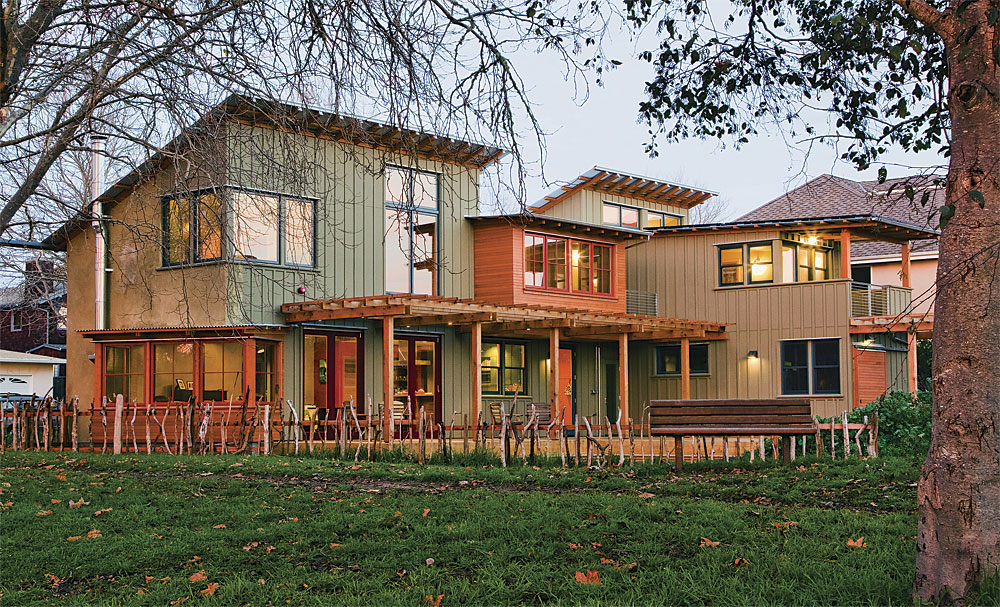

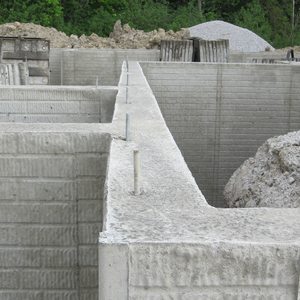






5 Comments
Good to see a move away from "energy efficient building" to more holistic metrics. Imagine how much simpler this would be if the price paid for things included their environmental impact.
Any mention of XPS carbon should be clear about which type of XPS.
I like the use of MCE in addition to OCE. But if we allow higher MCE as a trade-off for lower OCE in dirty-grid areas, that carbon cost is built into the building. The OCE goes down as the local grid gets cleaner, but MCE is permanent. And, the higher MCE is "spent" right now, when it is the most important to limit carbon emissions. I think I'd like to see the concept of MCE being incorporated into the building codes, but I'm not sure I'm sold on the overall CUI concept just yet. I can probably be convinced, though.
I do love the wishy-washy response from NAHB. "We're not sure our members are smart or flexible enough to deal with a new metric, and until we know how it will affect their bottom lines, we're not taking a stand either way. And no, we're not even going to study it for fear of the answers."
The ICC response was somewhat more intelligent, with at least consideration of the concept. But it still comes down to, "We're probably not going to make any decisions until the NAHB tells us what to think."
Pathetic. Why can't either organization say, "Wow. Yeah. We need to do everything we can to reduce both first- and operational-costs of carbon in our buildings, within all of the other constraints that our industry faces. This seems like an interesting way to measure those costs with a single metric that could be easy to implement. And having a consistent system to masure carbon costs that applies to all of North America would be an economic boon for cross-border trade. We'll certainly take a look at it. "
Really interesting article, Scott. Many things turn out differently than you first thought when analyzed carefully. I have seen brick fired and when seeing the process it becomes obvious this is a high-impact material, ditto portland cement. I don't know about the tradeoff, lower efficiency for a better carbon count, but maybe so. Assuming the grid improves over time, this may indeed make a lot of sense. Thanks for this thought-provoking piece.
I think the idea of factoring in longevity or maintenance costs from a carbon standpoint is a missing piece. Working on a renovation right now and thinking about long lasting metal framing or carbon negative wood framing. A major issue is considering how frequently I'll need to paint/take care of the wood and then the inevitable replacement cost (and associated carbon cost when replacing the frame every 10 years).
It does get hairy defining thing, but not impossible. Set a 50 year timeline and average maintenance, and it can be a good start I'd imagine?
Guillow, the new BEES 2 includes the cost of carbon in the LCA. This is a good reference point for what you're after. I wrote about BEES recently, at some point the article will come out here at GBA. Take a look, you may find it useful.
Log in or create an account to post a comment.
Sign up Log in